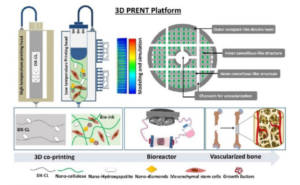3DPRENT
3D Printed Engineered Nano-Composite Templates for Bone Regeneration
Principal Investigator: Monica Sandri
Involved Personnel: Margherita Montanari
Starting date: 10/2020
Duration: 48 month
Total Funding: 1.037.135 €
Action: NANO2021 call 10 April 2019
CNR-ISTEC role: Partner
Coordinator: Ahmad Rashad Saad Mohamed Elsebahy, Kamal Babikeir Elnour Mustafa – Bergen University
Consortium: 10 partner. RISE PFI, Kungliga Tekniska Högskolan, Vestlandets Innovasjonsselskap, Polytechnica University of Bucharest, Høgskulen På Vestlandet, Fraunhofer-Institut für Grenzflächen- und Bioverfahrenstechnik, DiaCoating GmbH, Envisiontec GmbH, Consiglio Nazionale Delle Ricerche.
Sito ufficiale: tissueengineering.no/2020/10/23/research-council-of-norway-3/
3DPRENT aims to create three-dimensional (3D) printed engineered nano-composite templates for bone tissue regeneration. Recent clinical studies propose alternatives to conventional treatment modalities by using the concept of tissue engineering in which biomaterials (scaffolds) are used to deliver mesenchymal stem cells (MSC) and/or growth factors. Although there have been some successes, bone tissue engineering needs to overcome several challenges to meet clinical and commercialization needs. Among these challenges, the limitations of scaffolding biomaterials that can resemble macro to nanoscale structures of native bone tissues.
In 3DPRENT, nanocellulose-based hydrogel will be functionalized with nano-hydroxyapatite (nHA) for osteoconductivity and nano-diamond particles (nDP) to deliver vascular endothelial growth factor (VEGF) to bioprint mesenchymal stem cells (MSC). For mechanical stability and vascularization, hydrogel layers will be reinforced with 3D printed microchannel network of a thermoplastic polymer.
3DPRENT will develop not only outstanding basic scientific knowledge but also sustainable solutions and innovations based on nanotechnology, 3D printing and stem cells thus improving health and promoting new medical technology to meet the needs of society.
